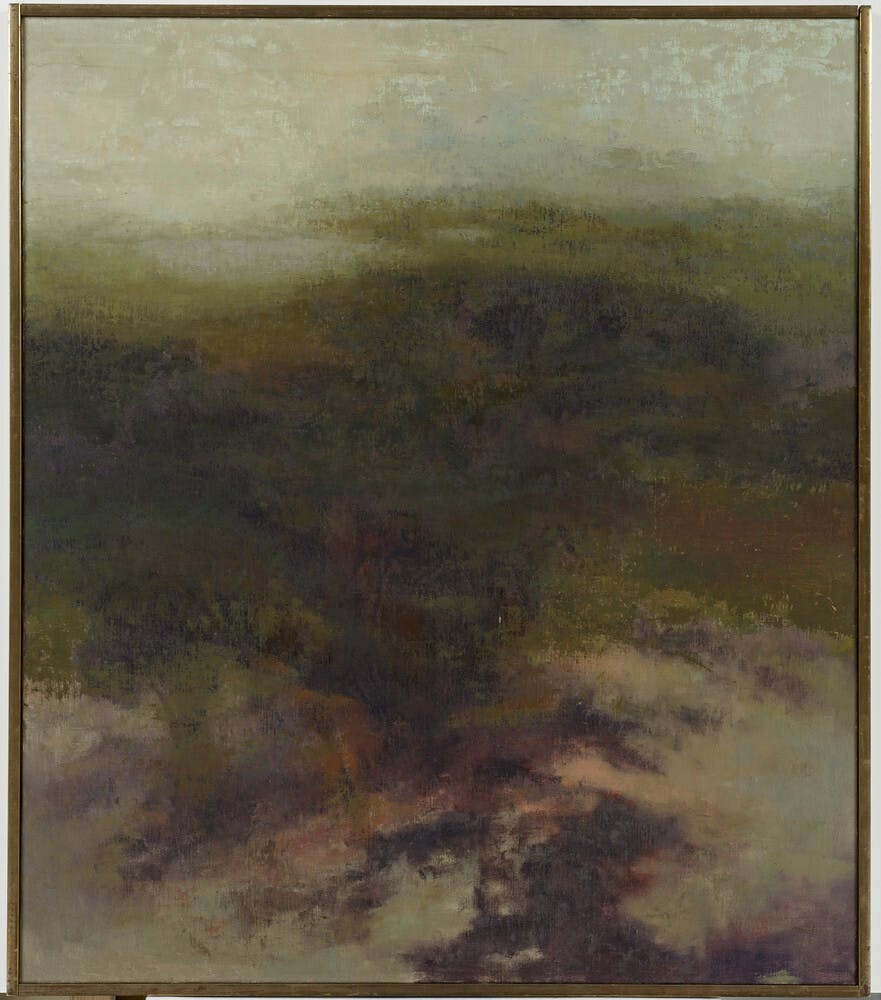Richard Mayhew
(1924–2024)Biography
Richard Mayhew examined the spirit of the time and of the civil rights movement through color.
Born and raised in Amityville on Long Island, Richard Mayhew spent summers observing the many artists who flocked to his hometown to paint its vistas and shorelines. At a young age, he borrowed brushes and paints from his father’s business to create his own work. His paternal grandmother supported his artistic inclinations and taught him about many Native Americans’ relationship to and kinship with the earth. One of the visiting artists recognized Mayhew’s promise and showed him the fundamentals of drawing and painting. At seventeen, Mayhew committed himself to becoming an artist.
In 1947, Mayhew moved to New York, where he was surrounded by the growing Abstract Expressionist movement. Through studies at the Brooklyn Museum Art School, Pratt Institute, and Columbia University, he explored the connection between landscapes and the spirituality at the center of his Shinnecock and Cherokee heritage. After his first solo museum show, in 1955, he won the John Hay Whitney Fellowship in 1959, and spent the following year studying at the Accademia delle Belle Arti in Florence. With the support of an additional grant from the Ford Foundation, Mayhew remained in Europe, where he found himself particularly inspired by the light and colors characteristic of French Impressionism. Upon returning to New York, he joined Spiral, a collective of Black artists focused on the political and cultural landscape of the United States. However, unlike the work of fellow Spiral artists Charles Alston, Hale Woodruff, and Norman Lewis, Mayhew did not use overt narrative or figurative elements, and instead examined the spirit of the time and of the civil rights movement through color.
In addition to his artistic career, Mayhew is a respected educator, having held positions at the Brooklyn Museum Art School, Art Students League, Smith College, and Pennsylvania State University. The Studio Museum has presented his work in numerous exhibitions, including Richard Mayhew: An American Abstractionist (1978); Represent: Selections from the Permanent Collection of The Studio Museum in Harlem (2006); and Spiral: Perspectives on an African American Art Collective (2011).
Richard Mayhew
(1924–2024)Gorge, 1966
Biography
Richard Mayhew examined the spirit of the time and of the civil rights movement through color.
Born and raised in Amityville on Long Island, Richard Mayhew spent summers observing the many artists who flocked to his hometown to paint its vistas and shorelines. At a young age, he borrowed brushes and paints from his father’s business to create his own work. His paternal grandmother supported his artistic inclinations and taught him about many Native Americans’ relationship to and kinship with the earth. One of the visiting artists recognized Mayhew’s promise and showed him the fundamentals of drawing and painting. At seventeen, Mayhew committed himself to becoming an artist.
In 1947, Mayhew moved to New York, where he was surrounded by the growing Abstract Expressionist movement. Through studies at the Brooklyn Museum Art School, Pratt Institute, and Columbia University, he explored the connection between landscapes and the spirituality at the center of his Shinnecock and Cherokee heritage. After his first solo museum show, in 1955, he won the John Hay Whitney Fellowship in 1959, and spent the following year studying at the Accademia delle Belle Arti in Florence. With the support of an additional grant from the Ford Foundation, Mayhew remained in Europe, where he found himself particularly inspired by the light and colors characteristic of French Impressionism. Upon returning to New York, he joined Spiral, a collective of Black artists focused on the political and cultural landscape of the United States. However, unlike the work of fellow Spiral artists Charles Alston, Hale Woodruff, and Norman Lewis, Mayhew did not use overt narrative or figurative elements, and instead examined the spirit of the time and of the civil rights movement through color.
In addition to his artistic career, Mayhew is a respected educator, having held positions at the Brooklyn Museum Art School, Art Students League, Smith College, and Pennsylvania State University. The Studio Museum has presented his work in numerous exhibitions, including Richard Mayhew: An American Abstractionist (1978); Represent: Selections from the Permanent Collection of The Studio Museum in Harlem (2006); and Spiral: Perspectives on an African American Art Collective (2011).


